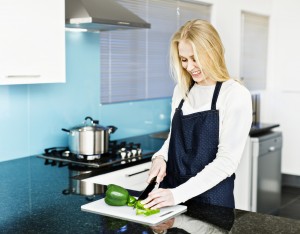A clean kitchen is the pride and joy of every household, what adds to the charm is if it is well-equipped and great food for family, friends or just oneself can be whipped up in a jiffy. Color these great qualities with a tinge of green with reduced wastage and more recycling to complete you beautiful kitchen.

Kitchen Energy Consumption
A kitchen would be the single point of the houses were maximum amount of the household energy would be consumed. Energy is consumed on gas for cooking food, electricity for the various appliances, the food itself and the treatment of leftovers. If objects such as jars, plates or glasses are broken, there is wastage again. In addition, cooking practices also make a lot of difference on how much energy is consumed. For instance, not placing the lid while letting food simmer means more time will be taken for it to cook, hence more gas or electricity will be used.

Saving Energy on Appliances
One standard practice to be adopted with appliances is to purchase energy efficient, 5-star rated appliances for the kitchen. These include the refrigerator, food processor and microwave oven. They will use up lesser amount of energy than the standard, unrated or low-rated appliances and help you save on energy bills.

Recycling in Kitchen
Segregate dry and wet waste by keeping separate bins for them. You can often reuse the dry waste for making or repairing something, if not it can be sold or at the very least help the garbage collectors. Wet waste can be used to make compost for the garden, so instead of throwing away the egg shells, vegetable and fruit peels and leftover food, you can dump it in a hole in the backyard to create your own compost. Broken bottles, glasses and containers can be used for planting instead of pots.

Minimizing Waste
If you have a gas cooking range, opt for cooking a low to medium heat as much as possible, this way you not only conserve energy but also add flavor to the food. Try and cook just as much food as is required and watch the faucet so that water is not dripping. Minimizing waste must be the first choice and recycling an alternative. Further, cut down unnecessary expenses by using what you have. For instance, instead of buying dishtowels, use paper or reusable bags and instead of throwing away plastic bags, reuse them when you go shopping to the supermarket.




